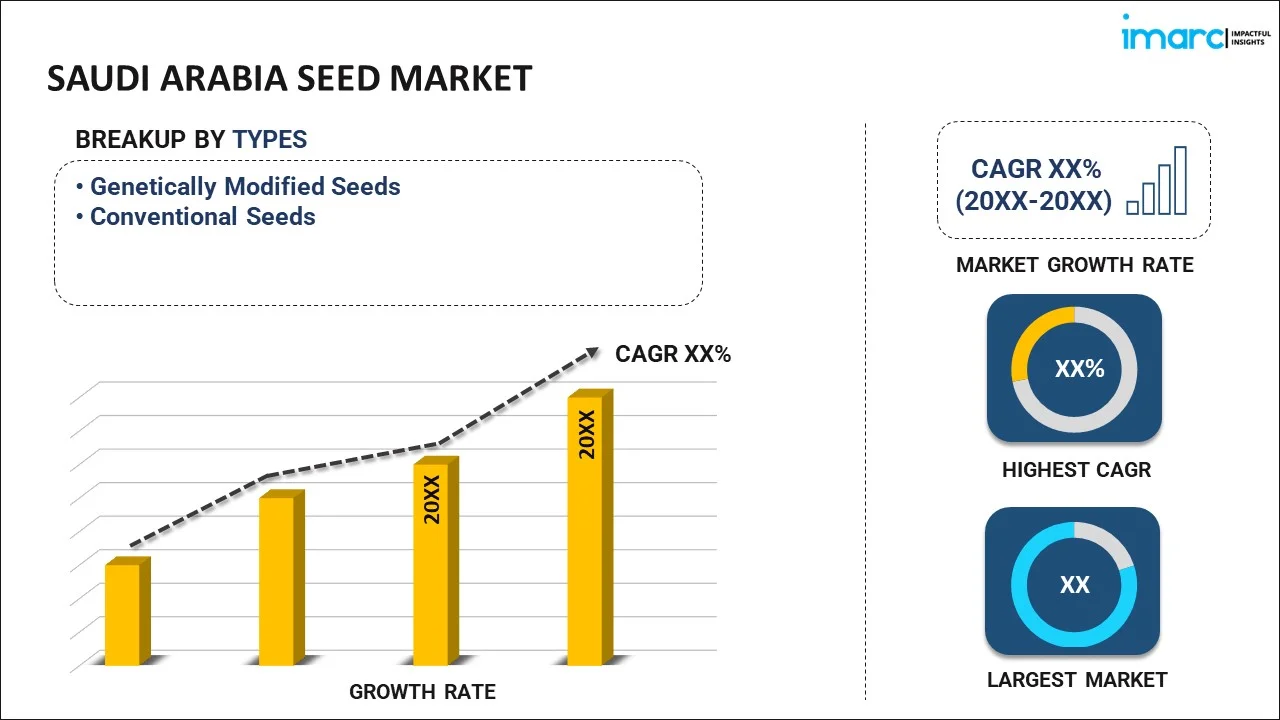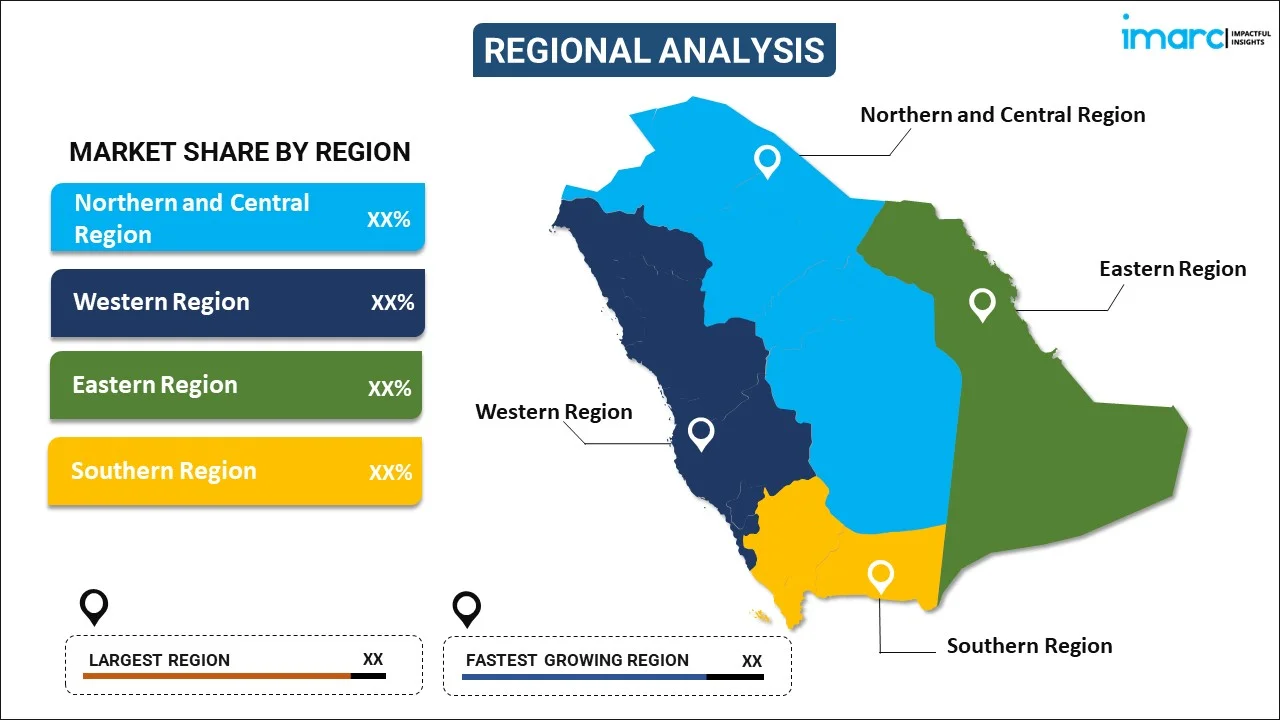
Saudi Arabia Seed Market Report by Type (Genetically Modified Seeds, Conventional Seeds), Seed Type (Oilseeds, Cereals and Grains, Fruits and Vegetables, Burpee and Park, and Others), Traits (Herbicide-Tolerant (HT), Insecticide-Resistant (IR), Other Stacked Traits), Availability (Commercial Seeds, Saved Seeds), Seed Treatment (Treated, Untreated), and Region 2025-2033
Market Overview:
Saudi Arabia seed market size reached USD 426.7 Million in 2024. Looking forward, IMARC Group expects the market to reach USD 682.4 Million by 2033, exhibiting a growth rate (CAGR) of 5.4% during 2025-2033. The increasing demand for seeds that are resilient to changing climatic conditions, such as drought-resistant or heat-tolerant varieties, is driving the market.
|
Report Attribute
|
Key Statistics
|
|---|---|
|
Base Year
|
2024
|
|
Forecast Years
|
2025-2033
|
|
Historical Years
|
2019-2024
|
| Market Size in 2024 | USD 426.7 Million |
| Market Forecast in 2033 | USD 682.4 Million |
| Market Growth Rate 2025-2033 | 5.4% |
A seed is an embryonic plant enclosed in a protective outer covering, often derived from the mature ovule of a flowering plant. It serves as the starting point for the growth and development of a new plant. Seeds contain genetic information essential for the plant's characteristics, such as its size, color, and reproductive abilities. They are a result of the fertilization process, combining genetic material from both parent plants. Seeds can remain dormant until favorable conditions for germination occur, ensuring the plant's survival and adaptation to its environment. Throughout history, seeds have played a crucial role in agriculture, serving as a primary means of crop propagation. Their diversity is vast, reflecting the incredible variety of plant life on Earth, and they have become symbolic of renewal, life cycles, and the interconnectedness of ecosystems.
Saudi Arabia Seed Market Trends:
The seed market in Saudi Arabia is propelled by several interconnected factors that collectively drive its growth and evolution. Firstly, the increasing regional population and the subsequent surge in food demand serve as a primary driver. Moreover, advancements in biotechnology play a pivotal role in shaping the seed market landscape. Biotechnological innovations have enabled the development of genetically modified (GM) seeds designed for improved pest resistance, drought tolerance, and higher nutritional content. Consequently, the adoption of these innovative seed varieties becomes a key driver, aligning with the overarching goal of sustainable agriculture. In addition to this, climate change exerts its influence on the seed market dynamics. Fluctuating climatic patterns necessitate the development of seeds that can withstand environmental challenges, such as extreme temperatures and erratic precipitation. This creates a demand for climate-resilient seed varieties, fostering R&D efforts within the seed industry. Furthermore, the expanding awareness and acceptance of sustainable agricultural practices contribute to the growth of the seed market. Consumers and farmers alike increasingly recognize the importance of environmentally friendly and socially responsible seed production, driving the demand for seeds that align with sustainable farming practices. In essence, a complex interplay of population dynamics, biotechnological advancements, climate considerations, and a shifting agricultural paradigm collectively propel the seed market forward in Saudi Arabia.
Saudi Arabia Seed Market Segmentation:
IMARC Group provides an analysis of the key trends in each segment of the market, along with forecasts at the country level for 2025-2033. Our report has categorized the market based on type, seed type, traits, availability, and seed treatment.
Type Insights:

- Genetically Modified Seeds
- Conventional Seeds
The report has provided a detailed breakup and analysis of the market based on the type. This includes genetically modified seeds and conventional seeds.
Seed Type Insights:
- Oilseeds
- Soybean
- Sunflower
- Cotton
- Canola/Rapeseed
- Cereals and Grains
- Corn
- Wheat
- Rice
- Sorghum
- Fruits and Vegetables
- Tomatoes
- Lemons
- Brassica
- Pepper
- Lettuce
- Onion
- Carrot
- Burpee and Park
- Others
- Alfalfa
- Clovers and Other Forage
- Flower Seed
- Turf Grasses
A detailed breakup and analysis of the market based on the seed type have also been provided in the report. This includes oilseeds (soybean, sunflower, cotton, canola/rapeseed, cereals and grains, corn, wheat, rice, and sorghum) fruits and vegetables (tomatoes, lemons, brassica, pepper, lettuce, onion, and carrot) burpee and park, and others (alfalfa, clovers and other forage, flower seed, and turf grasses).
Traits Insights:
- Herbicide-Tolerant (HT)
- Insecticide-Resistant (IR)
- Other Stacked Traits
The report has provided a detailed breakup and analysis of the market based on the traits. This includes herbicide-tolerant (HT), insecticide-resistant (IR), and other stacked traits.
Availability Insights:
- Commercial Seeds
- Saved Seeds
A detailed breakup and analysis of the market based on the availability have also been provided in the report. This includes commercial seeds and saved seeds.
Seed Treatment Insights:
- Treated
- Untreated
The report has provided a detailed breakup and analysis of the market based on the seed treatment. This includes treated and untreated.
Regional Insights:

- Northern and Central Region
- Western Region
- Eastern Region
- Southern Region
The report has also provided a comprehensive analysis of all the major regional markets, which include Northern and Central Region, Western Region, Eastern Region, and Southern Region.
Competitive Landscape:
The market research report has also provided a comprehensive analysis of the competitive landscape. Competitive analysis such as market structure, key player positioning, top winning strategies, competitive dashboard, and company evaluation quadrant has been covered in the report. Also, detailed profiles of all major companies have been provided.
Saudi Arabia Seed Market Report Coverage:
| Report Features | Details |
|---|---|
| Base Year of the Analysis | 2024 |
| Historical Period | 2019-2024 |
| Forecast Period | 2025-2033 |
| Units | Million USD |
| Scope of the Report | Exploration of Historical and Forecast Trends, Industry Catalysts and Challenges, Segment-Wise Historical and Predictive Market Assessment:
|
| Types Covered | Genetically Modified Seeds, Conventional Seeds |
| Seed Types Covered |
|
| Traits Covered | Herbicide-Tolerant (HT), Insecticide-Resistant (IR), Other Stacked Traits |
| Availabilities Covered | Commercial Seeds, Saved Seeds |
| Seed Treatments Covered | Treated, Untreated |
| Regions Covered | Northern and Central Region, Western Region, Eastern Region, Southern Region |
| Customization Scope | 10% Free Customization |
| Post-Sale Analyst Support | 10-12 Weeks |
| Delivery Format | PDF and Excel through Email (We can also provide the editable version of the report in PPT/Word format on special request) |
Key Questions Answered in This Report:
- How has the Saudi Arabia seed market performed so far and how will it perform in the coming years?
- What has been the impact of COVID-19 on the Saudi Arabia seed market?
- What is the breakup of the Saudi Arabia seed market on the basis of type?
- What is the breakup of the Saudi Arabia seed market on the basis of seed type?
- What is the breakup of the Saudi Arabia seed market on the basis of traits?
- What is the breakup of the Saudi Arabia seed market on the basis of availability?
- What is the breakup of the Saudi Arabia seed market on the basis of seed treatment?
- What are the various stages in the value chain of the Saudi Arabia seed market?
- What are the key driving factors and challenges in the Saudi Arabia seed?
- What is the structure of the Saudi Arabia seed market and who are the key players?
- What is the degree of competition in the Saudi Arabia seed market?
Key Benefits for Stakeholders:
- IMARC’s industry report offers a comprehensive quantitative analysis of various market segments, historical and current market trends, market forecasts, and dynamics of the Saudi Arabia seed market from 2019-2033.
- The research report provides the latest information on the market drivers, challenges, and opportunities in the Saudi Arabia seed market.
- Porter's five forces analysis assist stakeholders in assessing the impact of new entrants, competitive rivalry, supplier power, buyer power, and the threat of substitution. It helps stakeholders to analyze the level of competition within the Saudi Arabia seed industry and its attractiveness.
- Competitive landscape allows stakeholders to understand their competitive environment and provides an insight into the current positions of key players in the market.
Need more help?
- Speak to our experienced analysts for insights on the current market scenarios.
- Include additional segments and countries to customize the report as per your requirement.
- Gain an unparalleled competitive advantage in your domain by understanding how to utilize the report and positively impacting your operations and revenue.
- For further assistance, please connect with our analysts.
 Inquire Before Buying
Inquire Before Buying
 Speak to an Analyst
Speak to an Analyst
 Request Brochure
Request Brochure
 Request Customization
Request Customization




.webp)




.webp)












